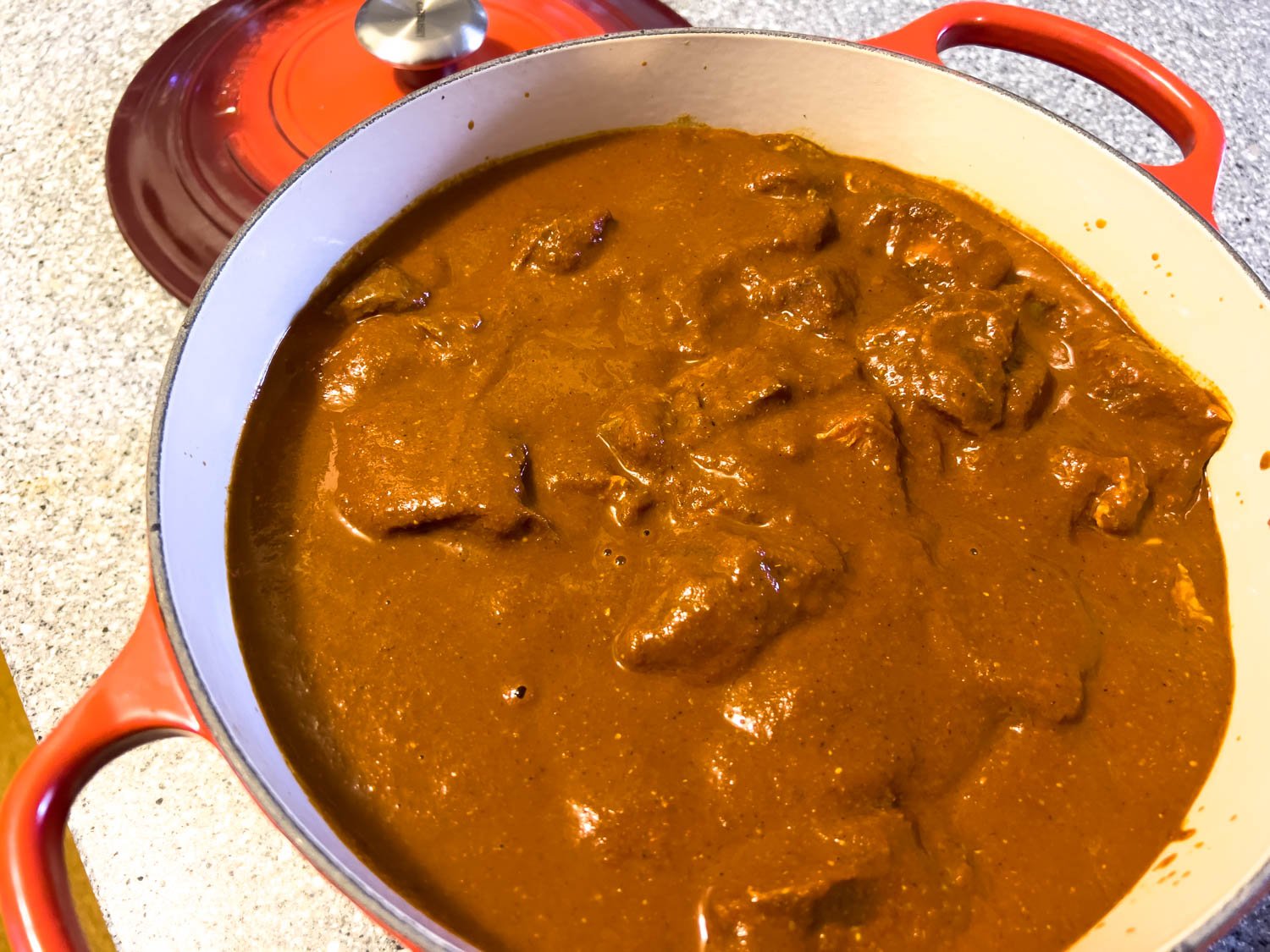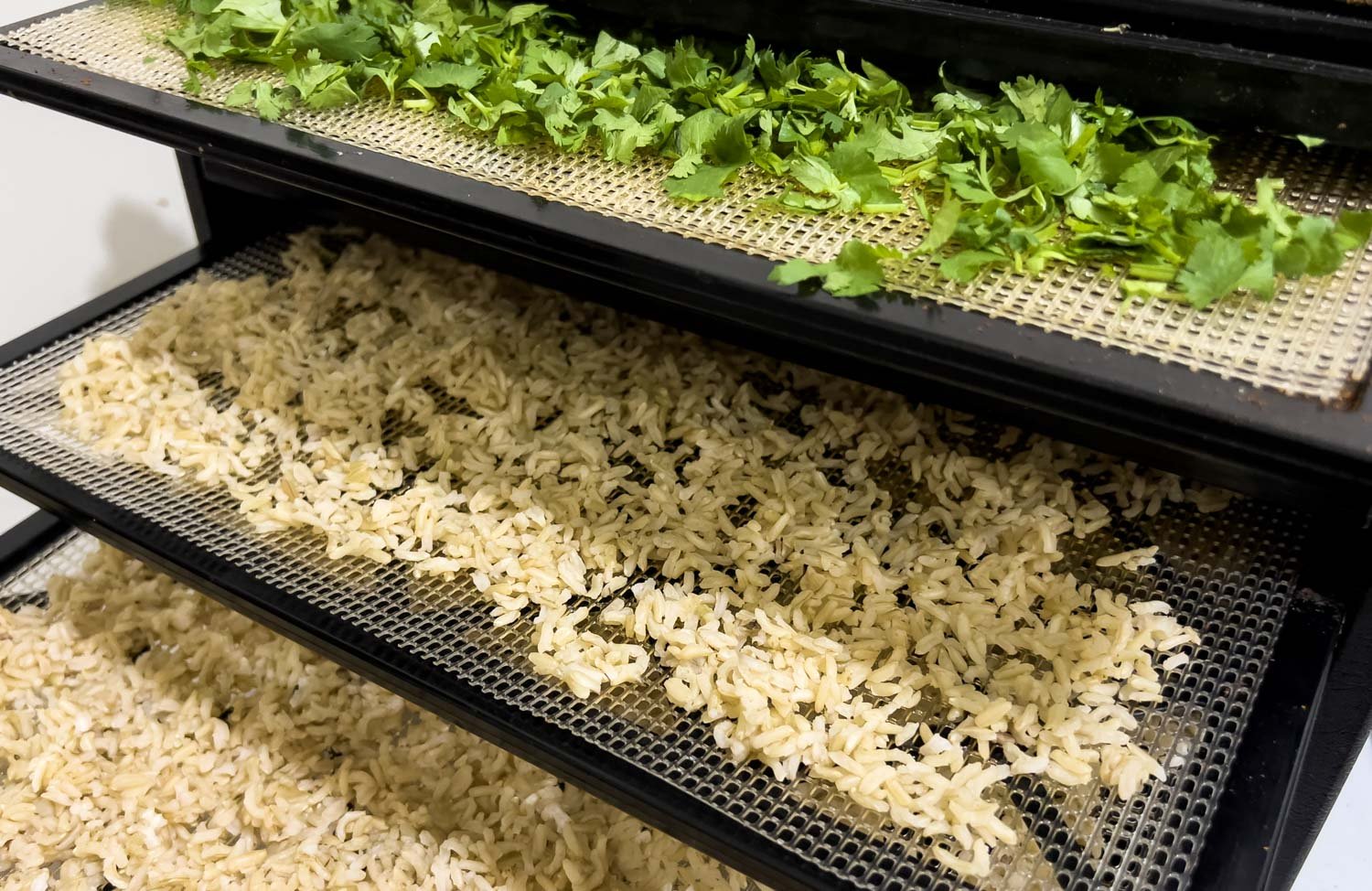Dehydrated Beef (or Chickpea) Vindaloo
A fantastic fiery and flavoursome curry with either the traditional meat base, or an equally delicious vegetarian version with chickpeas. Paired with brown rice or pearl barley, these protein-packed curries are sure to warm you after a long day’s hike!
We have adapted this dehydrated recipe from RecipeTinEat’s marvellous fresh version. Although we rarely use beef in our recipes, more sustainable alternatives such as goat, chicken and kangaroo will become stringy and dry when dehydrated because they need to be cooked for some time for the flavours to penetrate. However, canned chickpeas work really well, absorbing the flavour and with good texture.
In one test batch we used osso buco (beef shin), but the marrow comprises a lot of fat. We were able to carefully lift it out, and blot it from the top, but recommend trimmed chuck steak for dehydrating.
Our recipes are normally packed with vegetables but this one is an exception as it really benefits from less is more — it’s pretty much protein and carbs, though the chili powder equals plenty of capsicum! If you really want to add vegetables, try finely diced eggplant and mushrooms sauteed separately and added to the sauce after puréing the latter. Freeze dried peas added to the bag when packaging would taste good too.
We give you the instructions for the beef version first, with the recipe modifications for the chickpea version below it. The ingredients are almost the same except for obvious substitutions (meat, stock), but the method for cooking the chickpeas in the sauce differs.
This recipe benefits from olive oil or ghee stirred through just before serving in camp.
Ingredients*
2 kg chuck steak cut into 3cm pieces (not smaller) OR 10 cans chickpeas (total weight approx 2.4 kg drained)
4.5 tspn salt
2 bunches coriander
5 cups brown jasmine rice or pearl barley
Curry Paste:
120g kashmiri chilli powder (powders vary in heat so taste-test and adapt quantities to your liking!)**
5 tspn coriander seeds
8 tspn cumin seeds
10 cloves
10 green cardamon pods
5 tspn cinnamon powder
2 tspn black peppercorns
6 tbspn fresh ginger, chopped
25 garlic cloves, or 2-3 knobs, chopped
3 tspn brown sugar
2.5 tspn fenugreek seeds
3/4 tspn turmeric powder
300ml white vinegar
1.25L water or water from chickpea cans
Curry Sauce:
1 tbspn ghee or olive oil
3 medium onions, finely chopped
5 tspn ginger, grated
10 garlic cloves, finely chopped
4 1/2 tspn black mustard seeds
5 tbspn tomato paste
5 fresh curry leaves
1.25L beef stock (or vegetable stock if making chickpeas)
Optional: 1 kg mushrooms and/or eggplant in 1 cm dice***
Notes:
*These will almost fill 2 excalibur 9-trays. Dry the meat first, then the rice.
**In Australia, find Kashmiri chili powder in Asian supermarkets, some city supermarkets, or online here and many other places. You can often swap out curry ingredients, but this particular chilli powder is key to vindaloo’s distinctive red appearance and fruity spiciness; it’s really worth buying it online if you can’t find it locally.
***Optional ie only if you really want extra vegetables. Saute them separately in scant oil, then add to the curry sauce after pureeing the latter.
Method for Beef Vindaloo:
Mix beef with salt. Blend curry paste ingredients with 500ml water until smooth. Pour over beef, then rinse blender with remaining water and add that too. Mix well and marinate in refrigerator for a few hours.
Preheat oven to 190C (375F) or 170C (340F) fan-forced.
If using diced eggplant and/or mushrooms, fry them now, in batches, in very scant oil until golden. Set aside.
To make curry sauce, melt ghee or olive oil in a large, heavy-based oven-proof pot over medium high heat and saute onions, ginger and garlic 5 minutes or until translucent. Stir in mustard seeds and saute another few minutes, then add tomato paste. Cook a few minutes more, scraping the bottom to prevent it catching. Add stock, mix well, then tilt pot and blend with a stick blender until smooth (if you’re not making the full recipe, pour into a jug and blend to prevent splatter).
Add beef and curry leaves (and sauteed eggplant/mushroom), stir well and bring to the boil. Cover and place in oven for two to three hours. Check occasionally, and blot any oil from the surface with a paper towel.
When ready, the meat should fall apart if pressed against the side of the pot with a spoon, and the sauce should be thick with almost no oil on the surface (blot again if any remains). Taste and adjust seasonings.
With a wire skimmer, lift meat out of sauce and place on a large platter. Use two forks to shred meat just enough to ensure there are no thick chunks that wont’ dehydrate fully.
Weigh out two serves of meat, place on a tray and mark with a spoon; this is your MEAT WET MIX A.
Spread remaining meat onto trays.
Spread coarsely chopped coriander on a tray (or dry with rice later).
Spread sauce onto silicone- or baking-paper lined trays. Dehydrate at 63C (145F) until dry, stirring partway through to break up any clumps, and inverting sauce onto mesh.
Powder the sauce in a spice grinder, return to lined tray and dry another ten minutes. Place into a container and seal when cool.
When dry, weigh your marked trays to get MEAT DRY WEIGHT B for two serves.
Place meat into a second bowl, allow to cool then seal.
Place coriander into a third bowl, allow to cool then seal.
Cook rice in 6 cups stock or water until softened but still undercooked. Allow to absorb. Weigh out two serves of cooked rice (we eat about a cup each, 2 cups total), place on a tray and mark with a spoon; this is your RICE WET MIX A.
Spread remaining rice on other trays. Dry at 145F (63C) When dry, weigh marked tray: this is your RICE DRY MIX B. Place all rice into a third bowl. You’re ready to package!
Method for Chickpea Vindaloo
A vegan test batch. The chickpeas crack a little and are slightly less firm when rehydrated but still taste great.
Make the curry paste and curry sauce as above, using vegetable stock instead of beef stock and, if you like, the chickpea water from the cans instead of water: it is high in protein but will create a Farty Party in the tent!
Immediately combine them (plus sautéed mushrooms and/or eggplant if using) in a large, heavy-based oven-safe pot and bring to the boil, stirring constantly. Cover and place in the oven for two hours. Remove and allow to cool, then add drained chickpeas and allow to marinate for a few hours. Bring pot to the boil again, stirring gently. Taste and season. Remove from heat.
Use a wire strainer or colander to separate chickpeas and sauce. Reduce latter further on stovetop if necessary, then spread on trays, dry and powder as for beef vindaloo. Cook and dry rice as for beef vindaloo. Dehydrate chickpeas as for beef vindaloo. Dehydrate coriander as for beef vindaloo.
Packaging for Two
Place RICE B (two serves) into individual small ziplocs - you’ll be rehydrating rice and sauce separately so it isn’t a gluggy mess!
Into each vac seal bag place
MEAT B (2 serves meat) or CHICKPEAS B
Sauce powder, distributed evenly between the vac seal bags (about 80g per bag for us)
Coriander, distributed evenly between the vac seal bag
Freeze dried peas (if using)
1 x Rice ziploc
Par vac and seal. On the outside write RICE A - RICE B = W.r (we had 2 cups cooked rice 210g wet, 90g dry = approx 120ml to add in camp, but this depends on your rice and how much water it’s absorbed), and MEAT A - MEAT B = W.m. We had about 105g of dried meat and 80g of the sauce powder for two servings.
I store this dehydrated meal in the freezer rather than at room temperature.
In Camp:
Bring water to the boil, enough for rice plus meat ie. Wr+ W.m + a little extra for the powder to make the sauce.
Open top of bag and remove rice ziploc. Pour W.m plus the little extra for the sauce powder into the bag, close and place in cosy for 20-25 minutes (less for chickpeas). Keep remaining water for the rice in the pot. After 10-15 minutes, reheat the water remaining in the pot, add rice, cover and place pot in cosy.
When ready to eat, open vac bag and stir through olive oil or ghee, if using (we do recommend this).
To serve, with one eating out of the bag and one out of the pot:
Remove half the rice from the pot and place it on the upturned pot lid. Push remaining rice to one side, and decant half the sauce out of the bag into the pot. Add the rice from the pot lid into the bag.
Enjoy!









